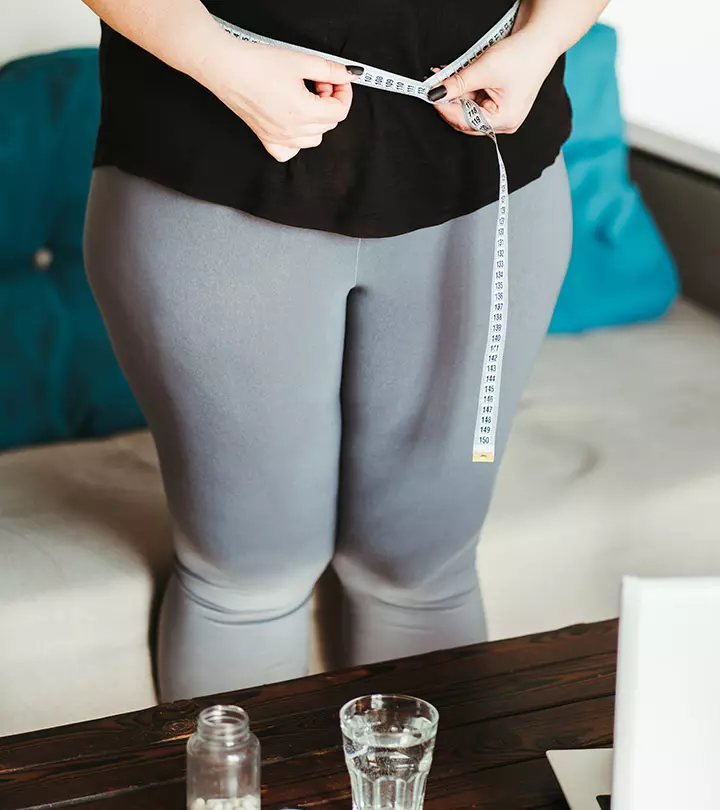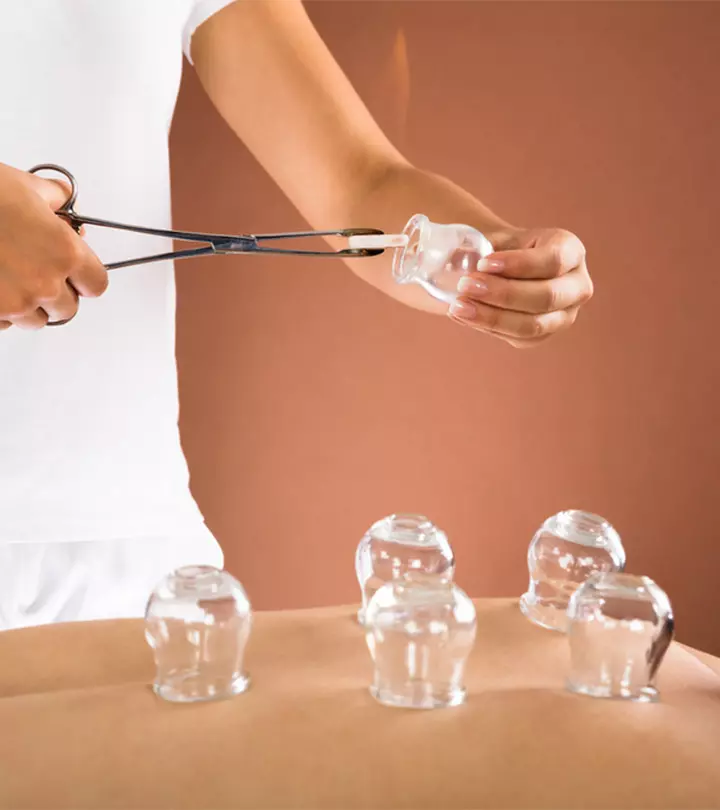Sauna Vs Steam Room: 10 Powerful Health Benefits To Try
Sweat out your toxins and the day's stresses as you sit back and unwind peacefully.

Image: Shutterstock
Ever contemplated if you should visit a sauna or a steam room? Which of the two could be better? Saunas or steam rooms have important health implications and are definitely worth a try. They can boost immunity, clean your skin, and offer other important health benefits.
Here, we discuss the important benefits of saunas, how they compare with steam rooms, and any potential side effects you must be wary about. Keep reading.
In This Article
What Is A Sauna?
Saunas can be classified as a form of therapy called thermotherapy stemming from more ancient forms known as geothermal therapy. The latter has been around for thousands of years, leading to the traditional Finnish saunas, which are examples of one of the most studied ones to date.
Saunas generally involve periodic exposures of about 5 to 20 minutes each at 80°C to 100°C with dry air. The humidity changes, starting at 10%, then to 20% scattered with periodic increases of more humidity, as water is thrown over heated rocks.
There are many types of saunas, including:
- IR saunas
- Dry saunas
- Wet saunas
- Smoke saunas
- Steam saunas
IR saunas are simple. They use infrared light and run at lower temperatures of (around 50°C to 60°C), but they are more powerful. Their exposure time is the same as a traditional Finnish sauna, but the wavelengths of the IR light change at different intervals.
In regards to IR saunas, “Not only does this help with sweating, which is a way to detoxify your body, but the infrared also helps with connective tissue healing, pain, as well as loosening up fasciai A thin casing of connective tissue that surrounds and holds every organ, blood vessel, bone, nerve fiber, and muscle in place. and muscles and tendons,” says Dr. Aaron Hartman, MD.
This is probably why IR saunas have been gaining popularity in the recent years.
The temperatures and settings may vary in different saunas, but the ultimate goal remains the same for all – cellular rejuvenation and healing of the mind, body, and spirit
 Fun Fact
Fun FactKey Takeaways
- Infrared saunas, smoke saunas, and steam saunas are some types of saunas.
- Sauna, especially the dry type, can help remove toxins from your body.
- Avoid using saunas if you are on medications that hamper your body’s temperature regulation or make you drowsy.
The Benefits Of Saunas
The benefits of sitting in a sauna are powerful, whether it be a Russian sauna, a Turkish sauna, or any other type of sauna.
About the various saunas, Dr. Alex Prevallet, Doctor of Osteopathic Medicinei A form of alternative medicine where the ailing person is approached as a whole instead of focusing on the symptoms in isolation. , says, “There are three main types of saunas – dry sauna, infrared, and steam. Most of the high-quality research has been done on the traditional dry sauna. However, there are increasing numbers of studies being performed on infrared saunas, and the data seem promising but less robust.”
Following are the benefits of saunas:
- Can Help Relieve Your Body Of Toxins
Your body is exposed to toxic chemicals daily, including environmental pollutants and the chemicals in the food you eat. Sauna exposure, especially the dry type, can promote detoxification by bringing out the toxins through sweat (1).
A study done on police officers exposed to a certain drug showed promising results (2). Sauna seems to help alleviate chronic symptoms that appear after chemical exposures. Sitting in a sauna may help cleanse your body from within.
- Can Help Relieve Stress

The heat in a sauna can elevate your body’s endorphin levels. Endorphins also include happy hormones such as dopamine and serotonin (1), (3). Saunas can benefit your overall psychei A term in Psychology that refers to the totality of the human mind and soul, including conscious and unconscious states. and promote mental health. Spending a recommended amount of time at the sauna may promote mental clarity and rejuvenate and refresh your mind.

Lucy, a blogger, shared how weekly sauna sessions help her relax in her blog. She explained, “During the session, I feel my body and mind relax completely, a feeling which continues for a good couple of days afterward – not to mention sleeping like a baby on those nights too (i).”
The Global Sauna survey from 2016-2017 highlights sauna-goers’ perceptions and self-perceived benefits of saunas. It had 482 respondents, 51.3% men and 48.7% women, who claimed to use the sauna 1-2 times a week. 83.5% of respondents reported improved sleeping patterns. It was also noted that those visiting the sauna 5-15 times a month had higher mental well-being scores. 93.1% of respondents also stated that adverse effects, if any, were mostly minor.
- Can Help Reduce Blood Pressure And Improve Blood Circulation
Saunas kick start the simple biological processes in your body. Studies have shown that the sauna’s ability to relax a person can help expand the blood vessels in one’s body. This can cause the blood flow to slow down and reduce pressure in the head, feet, and lungs (4). The pressure on the heart, in turn, reduces – and this improves blood circulation (4).
- May Help Reduce Cholesterol
In a study on postmenopausal women, researchers found quality time spent in a sauna to reduce total and bad cholesterol levels. It also increased the good cholesterol levels in the body (5). However, more research is needed in this regard.
- May Improve Symptoms Of Cardiovascular Disease
Dr. Prevallet says, “Higher-quality studies have shown that patients with congestive heart failure exposed to sauna therapy had fewer abnormal heartbeats, also known as PVCsi Premature Ventricular Contractions refer to extra heartbeats in ventricular chambers that disrupt regular heart rhythm. . Patients with peripheral arterial disease (PAD), the narrowing of the arteries that supply the extremities, have also benefited from sauna therapy.”
Reduced blood pressure, cholesterol, and better circulation can lead to better heart health. Saunas may reduce the risk of cardiovascular disease (4).
- May Benefit Your Skin

Saunas may reduce the pH of your skin (6). They also reduce the skin’s salt content, make the skin smoother, and add more glow. In addition, the anti-toxin activity of high heat and humidity can keep the skin more rejuvenated from its deepest layer.
“The heavy sweating induced in the heat also has a sort of cleansing effect on your pores and glands by flushing out toxins and impurities. This process could lead to healthier skin that’s less prone to breakouts. The heat can also rid dead skin cells and promote the growth of healthy new ones,” says Dr. Annie Gonzalez, a board-certified dermatologist.
- May Strengthen Your Immune System
Depression, anxiety, and stress are all the body’s responses to fight off excessive oxidative stress on the brain (7). It causes an inflammatory response, leading to situations where you feel low or suddenly are filled with fear about a given situation. Saunas have been proven to provide an immune system boost and improve its response in athletes and non-athletes, potentially reducing all these symptoms (4), (8).
- May Help Treat Arthritis

Infrared sauna treatment seems to offer some relief from rheumatoid arthritisi An autoimmune, inflammatory condition where the body’s immune system mainly attacks healthy cells in the joints. inflammation (9).
Dr. Bailey says, “This physiological process helps to relieve tightness and tension in both sore muscles and joints. As such, saunas can be incredibly beneficial for those with arthritis and joint pain.”
However, more research is warranted in this regard.
- May Aid In Quicker Muscle Recovery

Dr. Gonzalez says, “When a person works out vigorously, tiny tears can form in their muscles. When tears heal, muscles grow and become stronger.
The heat from a sauna can increase blood circulation to torn muscles and help them repair themselves more quickly. Saunas also decrease muscle soreness and tension and help you feel more relaxed and prepared for their next workout.”
10. May Help Treat Asthma
In a study conducted on Caucasian men aged 42–61 years, participants who had 2-3 or more sauna sessions per week were found to have a lower risk of acute and chronic respiratory conditions (10). Another study indicated that dry saunas may help reduce the risk of bronchial asthma in children (11). However, more research is needed to explore these benefits in greater depth.
On the other hand, some anecdotal evidence also suggests that the low humidity in a sauna bath may cause discomfort to people with asthma, especially if they have a sensitivity to dry air. Further, the heat in a bathing sauna may thicken mucus and make breathing difficult in some individuals.
Hence, consult your healthcare provider before taking a sauna bath to determine if it suits you.
These are the potential benefits of using a sauna bath. Now let’s explore some pro tips to keep in mind.
Pro Tips While Using The Sauna
Preparing your body for the fluid loss that can occur during sauna sessions is key. Start by drinking 475-590 ml (about half a liter) of water before entering the sauna, and then remember to rehydrate afterward. You can also consider coconut water or electrolyte drinks to help restore lost minerals.
Dr. Bailey has this to say about the time spent in a sauna room:
“Spending 15 minutes in a sauna allows time for creative thinking and self-reflection. This free flow of thought can be greatly beneficial for our mental health, leaving us invigorated and confident after a short stint in the heat.”
When it comes to the addition of essential oils and the sauna, Adora Winquist, an aromatherapist, says, “The addition of aromatics to the sauna holistically enhances the experience. You can use essential oils to help with the repatterning of your brain and cells. Essential oils can shift the trajectory of our emotional response at the moment through inhalation of the right oil and the right formulation.
Like a stepping stone effect, when we shift our emotional response, we can also shift our thinking process. This ultimately guides us and shifts our consciousness as a whole to the present moment, reducing anxiety and stress. Eucalyptus oil also carries the vibration of expansion and freedom. It is an oil of emotional liberation, assisting us to let go of stuck emotions and old patterns of being harsh and judgmental of ourselves.”
You can use essential oils in both saunas and steam rooms. But which of the two is better? Keep reading to know.
Saunas Vs. Steam Rooms
The biggest difference between a sauna and a steam room is the humidity level. A sauna runs on dry heat at lesser humidity. A steam room has higher humidity.
At a sauna, the heat comes from water hitting dry heated rocks. On the other hand, water vapor creates steam in a steam room.
Though both have various advantages, the ones that set them apart are:
- In a sauna, dry heat has been shown to reduce arthritis symptoms, joint pains, and other forms of body pain.
- In a steam room, the vapor reduces and clears congestion. Using essential oils like eucalyptus and chamomile can further help here.
The key difference between a sauna and a steam room is given in the table below, which helps you make the right choice for yourself.
| Feature | Sauna | Steam room |
|---|---|---|
| Temperature | Typically 150-190°F (65-88°C) | Typically 110-120°F (43-49°C) |
| Heat source | Dry heat from heated rocks or stoves | Moist heat from steam generators |
| Humidity | Low humidity (5-30%) | High humidity (100%) |
| Health benefits | Promotes detoxification, improves circulation, and relaxes muscles | Relieves congestion, improves skin health, and promotes relaxation |
| Duration of use | Typically 10-20 minutes | Typically 15-20 minutes |
| Drawbacks | Too hot for some, may dry out skin | Too humid or uncomfortable for prolonged use |
So, you can weigh your options and pick one according to the solution you are looking for. Although both work to achieve relaxation and offer health benefits, those with dry skin can use steam rooms, while saunas are better for greasy skin.
But could the extended exposure to heat affect your body negatively? Let us understand more.
Risks Of Using Saunas

While there are many benefits, saunas can cause a few ill effects too. Fortunately, though, these seem to be rare. The major effects saunas may cause include:
- Mild discomfort due to heat
- Low blood pressure
- Excessive and frequent urination
- Hypovolemia (low plasma liquid level)
None of the studies reported any severe side effects of using a sauna frequently (1).
 Trivia
TriviaTherefore, it could be safe to say that using saunas has more benefits than side effects (mild). But when should you not go to a sauna?
When To Avoid Saunas
Dr. Gonzalez gives these pointers.
- Avoid a sauna if you take medications that make you drowsy or interfere with your body’s ability to regulate temperature.
- Some doctors recommend avoiding saunas during pregnancy. Hence, speak to your doctor first if you plan to become pregnant or are pregnant before using a sauna.
- If you are ill, wait until you have recovered before using a sauna.
- Individuals with low blood pressure should also talk to a doctor to make sure it is safe to use a sauna because it may cause blood pressure to fall.
Saunas or thermotherapy involve periodic exposure to heated dry air with temperatures between 80 to 100 degrees for 10 to 20 minutes at a time. The three most common types of saunas are dry, steam, and infrared. Some of the various benefits of sauna, such as removing toxins from the body, promoting pain relief in individuals with rheumatoid arthritis, boosting immunity, etc., have been studied extensively, especially concerning dry saunas. Additionally, sauna sessions may also result in improved circulation, promote stress relief, and boost skin health. Saunas may trigger some side effects like frequent urination, discomfort with heat, and low blood pressure, but such cases are rare. However, note that you should avoid going to the sauna if you take medications that make you drowsy.
Frequently Asked Questions
Is it healthy to have a sauna every day?
Yes, it is safe to have a sauna every day. It may even help boost your cardiovascular health. Sauna enthusiasts were 23 % less likely to die of coronary heart disease or cardiovascular disease than those who only took one sauna per week (12).
Do you burn calories in a sauna?
Yes, but not significantly. Anecdotal evidence suggests that a 15-30 minute sauna session allows you to burn 1.5 – 2 times as many calories as sitting anywhere else. However, it is not an effective method for weight loss. Hence, seeking only a sauna for weight loss is not the ultimate solution, though, it can help detoxify and improve overall well-being.
Can I bring my phone to a sauna?
No. Sauna has an extremely high temperature that will damage your phone.
Should I shower after the sauna?
Yes. After the sauna, wait for a couple of minutes and take a cold shower.
Illustration: Benefits Of Sauna And Some Pro Tips While Using The Sauna

Image: Stable Diffusion/StyleCraze Design Team
Discover the numerous health benefits of saunas and elevate your well-being. From relaxation to detoxification, this video explores the transformative power of sauna therapy. Watch now and prioritize your health.
Personal Experience: Source
StyleCraze's articles are interwoven with authentic personal narratives that provide depth and resonance to our content. Below are the sources of the personal accounts referenced in this article.
i. Infrared Sauna At Kardia Skin + Body: The Ultimate De-Stresshttps://sayslucy.wordpress.com/tag/wellbeing/
References
Articles on StyleCraze are backed by verified information from peer-reviewed and academic research papers, reputed organizations, research institutions, and medical associations to ensure accuracy and relevance. Read our editorial policy to learn more.
- Clinical Effects of Regular Dry Sauna Bathing: A Systematic Review
https://www.ncbi.nlm.nih.gov/labs/pmc/articles/PMC5941775/ - Methamphetamine exposure and chronic illness in police officers
https://www.ncbi.nlm.nih.gov/labs/pmc/articles/PMC3573677/ - How the sauna affects the endocrine system
https://pubmed.ncbi.nlm.nih.gov/3218898/ - Cardiovascular and Other Health Benefits of Sauna Bathing: A Review of the Evidence
https://pubmed.ncbi.nlm.nih.gov/30077204/ - Changes in the lipid profile of blood serum in women taking sauna baths of various duration
https://pubmed.ncbi.nlm.nih.gov/20682487/ - Effect of regular sauna on epidermal barrier function and stratum corneum water-holding capacity in vivo in humans: a controlled study
https://www.ncbi.nlm.nih.gov/pubmed/18525205 - The concept of depression as a dysfunction of the immune system
https://www.ncbi.nlm.nih.gov/labs/pmc/articles/PMC3002174/ - Effect of a single Finnish sauna session on white blood cell profile and cortisol levels in athletes and non-athletes
https://pubmed.ncbi.nlm.nih.gov/3218898/ - Infrared sauna in patients with rheumatoid arthritis and ankylosing spondylitis – Clinical Rheumatology
http://link.springer.com/10.1007/s10067-008-0977-y - Sauna bathing reduces the risk of respiratory diseases: a long-term prospective cohort study
https://pubmed.ncbi.nlm.nih.gov/28905164/ - The effect of the Finnish dry sauna on bronchial asthma in childhood
https://pubmed.ncbi.nlm.nih.gov/2281065/ - Sauna bathing: a warm heart proves beneficial
https://www.ncbi.nlm.nih.gov/pmc/articles/PMC4409598/
Read full bio of Dr. Henok Malede
Read full bio of Gayathri Vijay
Read full bio of Arshiya Syeda
Read full bio of Payal Karnik


















Community Experiences
Join the conversation and become a part of our empowering community! Share your stories, experiences, and insights to connect with other beauty, lifestyle, and health enthusiasts.